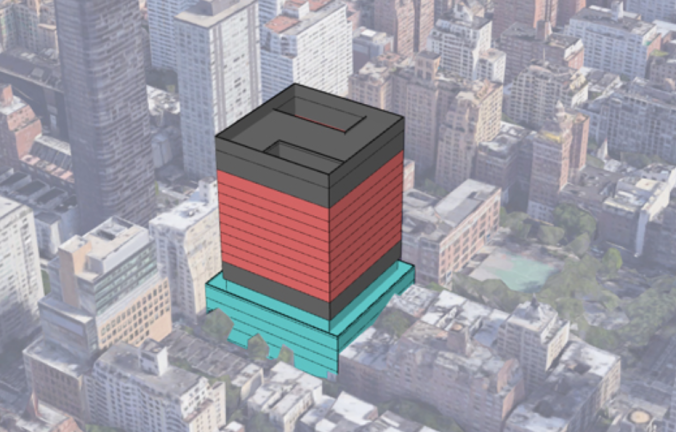No Compromise on Blood Center
At a City Planning Commission hearing, representatives of NYBC offer few changes to offset community concerns

Officials representing the New York Blood Center were questioned by City Planning commissioners on their proposal to build a 334-foot life sciences hub at its Upper East Side location during a public hearing downtown Thursday, particularly on whether NYBC has considered alternate plans to a project that has received intense opposition from the community.
The hearing was the latest step in the city’s Uniform Land Use Review Process, which is required since the project demands a change in zoning. As designed, the project would be a modernization of the Blood Center’s headquarters at East 67th Street, which would take up four floors of the building, as well as 11 floors of commercial space that developers say will be leased to nonprofit life science organizations. Partnering with NYBC is the Boston-based real estate group Longfellow, which has experience in building such life science hubs. Longfellow would finance the construction of the new building and own the top commercial office and lab space while NYBC would own its four floors.
With research institutions such Weill Cornell Medical, Memorial Sloan Kettering, and Rockefeller University within a few blocks of the prospective site, officials representing NYBC have argued the project offers a great opportunity for future collaboration and to create a true life sciences hub on the UES.
The hearing did not greatly deviate from the script of the public testimony given in hearings held on the topic thus far as opponents presented their concerns to the commission, explaining that the community has taken issue with the height of the building and the residential to commercial zoning it would require; the new afternoon shadows the tower would cast on the nearby St. Catherine’s Park and Julia Richman Education Complex, which houses some students with autism and other special needs; the inclusion of bio-safety level 3 labs, which tend to handle dangerous pathogens; as well as a perceived refusal on the part of NYBC to heed the community’s concerns and compromise.
“Mitigating” the Effects
That perceived refusal to compromise was confronted by the Commission on Thursday.
Commissioner Anna Hayes Levin asked what alternatives the Blood Center has considered in light of the community’s concerns.
Paul Selver, the Blood Center’s land use attorney who has been representing the blood center in the public hearings, said NYBC and Longfellow have been considering ways of “mitigating” the effects of constructing a building of that height in the neighborhood (such as the shadows cast on the adjacent school and park), so as long their effort does not “impact (NYBC’s) programmatic goals.”
“We’re exploring ways to reshape the top of the building to squeeze it down a little bit in terms of its height, which will reduce the shadow on the park,” said Selver. “There’s a question about how far we’re able to go and still take the project in a form that works for the Blood Center, and that has the critical mass of space to support the programmatic goals of creating a life sciences hub.”
When pressed, Selver said Longfellow and NYBC were not considering on reducing the number of floors or the floor to ceiling height. Selver said he and NYBC have tried to work with the Julia Richmam school to see how best to mitigate the impact of the shadows, but that their messages have gone unreturned.
Funding Support
Additionally, Levin asked if the Blood Center are willing to expand their facilities as of right – meaning within the restrictions of the neighborhood’s zoning law – and without the inclusion of Longfellow since the community would support that option.
Barry Greene, who serves as a vice president for the Blood Center, said that without the funding support from Longfellow, the expansion would not be possible.
“We rely on our endowment to fund operations and carry out our dual missions of supplying transfusion products and conducting scientific research. Longfellow provides the necessary expertise in life sciences and lab development to build the project and realize our vision to transform the site into a vibrant hub of life sciences and Biotech,” said Greene. “This vision of Center East will bring together the Blood Center as an anchor with other bio science research partners including startups and mature biotech companies, creating a collaborative ecosystem that furthers basic research, drug commercialization and build a more robust life science community in New York City, fueling economic growth.”
Selver added that the NYBC does not see taking on the project without Longfellow as a viable option.
So far in the official land use process, both Community Board 8 and Manhattan Borough President Gale Brewer have recommended to the CPC that it reject the Blood Center’s rezoning request. The CPC do have the power to kill the project if the majority of its 13 members vote it down.
The CPC’s 60-day window to make a decision began Thursday.